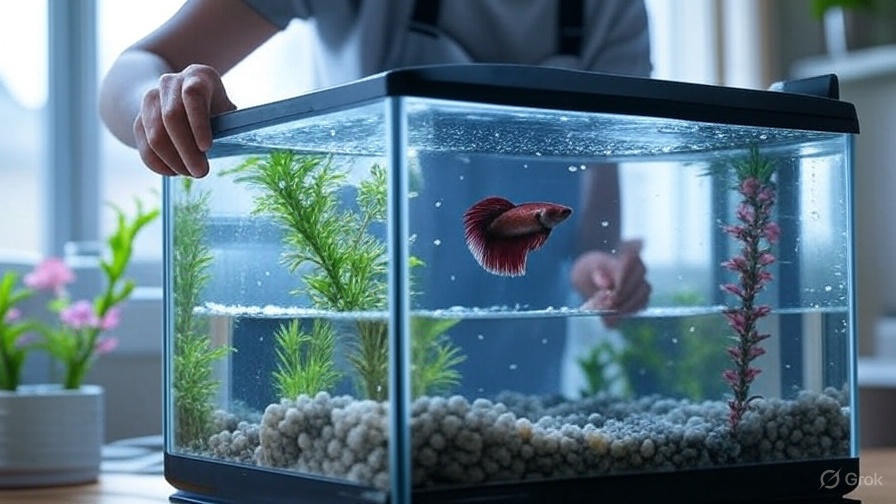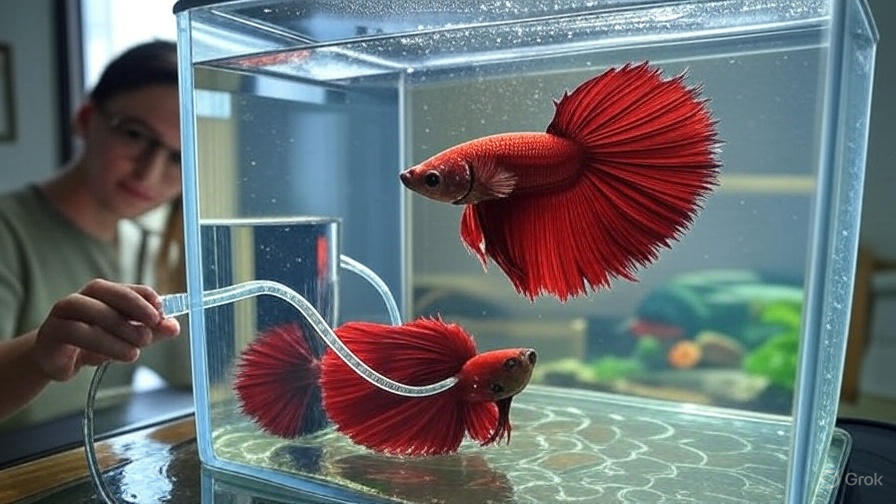How to Clean a Betta Fish Tank?
Betta fish captivate aquarium enthusiasts with their vibrant colors and flowing fins. These beautiful creatures deserve a pristine environment to thrive and live their best lives. Clean water keeps your betta healthy, reduces stress, and prevents deadly diseases that can quickly harm your beloved pet.
Many new betta owners struggle with proper tank maintenance. They often wonder how frequently they should clean their tank, what tools they need, and which cleaning methods work best. This comprehensive guide walks you through every aspect of betta tank cleaning, from daily maintenance to deep cleaning procedures.
Why Clean Water Matters for Betta Fish Health
Betta fish produce waste continuously through their gills, digestive system, and general metabolism. This waste breaks down into harmful compounds like ammonia and nitrites that poison your fish if left unchecked. Dirty water also encourages harmful bacteria growth, leading to fin rot, ich, and other serious health problems.
Clean aquarium water maintains proper pH levels between 6.5 and 7.5, which bettas need for optimal health. The right water conditions support their immune system and help them display their natural behaviors like building bubble nests and exploring their environment.
Regular cleaning removes uneaten food particles that decay and contaminate the water. Food debris creates ammonia spikes that stress your betta and can cause sudden death. Fresh, clean water also improves oxygen levels, helping your betta breathe easier and stay active throughout the day.
Essential Supplies for Betta Tank Cleaning
Before starting your cleaning routine, gather the right aquarium supplies to make the process smooth and effective. You’ll need a gravel vacuum or siphon to remove debris from the substrate. This tool sucks up waste while preserving beneficial bacteria in your tank’s biological filter.
Get an algae scraper or magnetic cleaner to remove algae buildup from glass surfaces. Algae blocks light and makes your tank look unsightly, though small amounts actually benefit your aquarium ecosystem. A dedicated aquarium sponge helps clean decorations and equipment without introducing harmful chemicals.
Stock up on water conditioner to neutralize chlorine and chloramine in tap water. These chemicals kill beneficial bacteria and harm your betta’s sensitive gills. You’ll also need clean buckets designated only for aquarium use – never use buckets that have contained soap or household cleaners.
Consider getting aquarium salt for treating minor health issues and stress. Pure aquarium salt differs from table salt and helps heal fins while reducing harmful bacteria. A reliable aquarium thermometer ensures water temperature stays between 76-82°F during and after cleaning.
How Often Should You Clean Your Betta Tank?
Tank size directly affects your cleaning schedule. Small tanks under 5 gallons require partial water changes twice per week, while larger tanks need weekly maintenance. Smaller volumes of water accumulate toxins faster, demanding more frequent attention to keep your betta safe.
Filtered tanks need less frequent water changes than unfiltered setups. A good biological filter processes waste and maintains water quality between cleanings. However, even filtered tanks require regular maintenance to remove accumulated debris and refresh water parameters.
Watch for signs that indicate immediate cleaning needs. Cloudy water, strong odors, algae overgrowth, or lethargic behavior from your betta all signal water quality problems. Test strips help monitor ammonia, nitrite, and nitrate levels to determine when cleaning becomes urgent.
Overfeeding creates more waste and requires more frequent cleaning. Feed your betta only what they can consume in 2-3 minutes, removing any leftover food immediately. This practice reduces waste production and extends the time between necessary water changes.
Step-by-Step Tank Cleaning Process
Start by unplugging your heater and filter to prevent damage during cleaning. Let the heater cool for 15 minutes before removing it from the water. Never remove a hot heater from water, as rapid temperature changes can crack the glass.
Remove your betta carefully using a soft net, placing them in a temporary container filled with their original tank water. Keep this container covered to prevent jumping, and ensure the water temperature matches their main tank. Never use fresh tap water for temporary housing.
Begin cleaning by scraping algae from the glass walls using your algae scraper. Work from top to bottom, allowing scraped algae to settle on the substrate for removal during vacuuming. Clean all visible surfaces, including decorations and equipment that will remain in the tank.
Use your gravel vacuum to remove 25-30% of the tank water while simultaneously cleaning the substrate. Insert the vacuum tube into the gravel and allow debris to flow out with the water. Move systematically across the entire bottom surface, spending extra time in areas where waste tends to accumulate.
Deep Cleaning vs. Regular Maintenance
Regular weekly maintenance involves partial water changes and basic cleaning tasks. This routine maintains water quality without disturbing beneficial bacteria colonies that keep your tank healthy. Weekly cleaning prevents waste buildup and maintains stable water parameters.
Deep cleaning becomes necessary every 4-6 weeks or when algae growth becomes excessive. This process involves removing all decorations for thorough cleaning and performing larger water changes. Deep cleaning disrupts the tank environment more but removes stubborn buildup that regular maintenance cannot address.
During deep cleaning, remove plastic plants and decorations for scrubbing with an aquarium-safe brush. Rinse everything thoroughly with hot water – never use soap or household cleaners that leave harmful residues. Clean artificial plants by soaking them in a diluted bleach solution, then rinsing extensively before returning them to the tank.
Real plants require gentler handling during deep cleaning. Remove dead or dying leaves, and gently brush algae from healthy foliage. Live plants actually help maintain water quality by absorbing nitrates and producing oxygen, making them beneficial additions to your betta’s environment.

Water Treatment and Conditioning
Tap water contains chlorine and chloramine that kill beneficial bacteria and harm your betta’s gills and skin. Always treat replacement water with a quality water conditioner before adding it to your tank. Add the conditioner directly to the replacement water, not to the tank itself.
Temperature matching prevents shock that can stress or kill your betta. Use a thermometer to ensure replacement water matches your tank temperature within 2-3 degrees. Sudden temperature changes disrupt your betta’s metabolism and weaken their immune system.
Let treated water sit for 10-15 minutes before adding it to your tank. This waiting period allows the conditioner to neutralize all harmful chemicals completely. Pour the new water slowly into the tank to avoid disturbing your betta and disrupting the substrate.
Test water parameters after cleaning using aquarium test strips or liquid test kits. Check pH, ammonia, nitrite, and nitrate levels to ensure they fall within safe ranges. Document these readings to track changes over time and identify potential problems early.
Filter Maintenance for Betta Tanks
Clean filter media every 2-3 weeks to maintain proper water flow and biological filtration. Rinse sponges and bio-media in tank water you’ve removed during cleaning – never use tap water that kills beneficial bacteria. Squeeze sponges gently to remove debris while preserving bacterial colonies.
Replace disposable filter cartridges according to manufacturer recommendations, typically every 4-6 weeks. However, avoid replacing all filter media at once, as this removes beneficial bacteria and can cause ammonia spikes. Stagger replacements to maintain biological filtration continuity.
Carbon filter media removes chemicals and odors but needs monthly replacement to remain effective. Exhausted carbon actually releases absorbed toxins back into the water, making timely replacement crucial. Remove carbon during medication treatments, as it neutralizes therapeutic compounds.
Check filter impellers and motors monthly for debris buildup that reduces efficiency. Clean impeller housing with a soft brush and rinse the impeller itself under running water. Lubricate o-rings with aquarium-safe lubricant to prevent leaks and maintain proper sealing.
Common Cleaning Mistakes to Avoid
Never clean your entire tank at once, as this removes beneficial bacteria and disrupts the nitrogen cycle. Complete tank overhauls shock your betta and can trigger new tank syndrome, where toxic ammonia levels spike dangerously. Always maintain at least 70% of the original water during routine cleaning.
Avoid using soap, detergent, or household cleaners on any aquarium equipment. These products leave residues that poison fish even in tiny amounts. Use only hot water and dedicated aquarium cleaning products that are safe for fish and beneficial bacteria.
Don’t ignore your cleaning schedule because the water looks clear. Invisible toxins like ammonia and nitrites can reach lethal levels before causing visible water problems. Consistent maintenance prevents these silent killers from harming your betta.
Resist the urge to over-clean when you notice minor algae growth. Small amounts of algae actually benefit your tank ecosystem by producing oxygen and consuming excess nutrients. Excessive cleaning disrupts natural balance and can cause water chemistry swings that stress your fish.
Troubleshooting Water Quality Issues
Cloudy water often indicates bacterial blooms caused by overfeeding or insufficient filtration. Reduce feeding amounts and increase water change frequency until the cloudiness clears. Adding beneficial bacteria supplements can help restore biological balance more quickly.
Green water results from algae blooms triggered by excess light and nutrients. Reduce lighting duration to 6-8 hours daily and perform extra water changes to remove excess nutrients. Consider adding live plants that compete with algae for nutrients.
Persistent odors signal decomposing organic matter or inadequate filtration. Check for dead fish, uneaten food, or decaying plant matter that needs removal. Increase water change frequency and ensure your filter operates properly to process waste effectively.
Sudden pH swings can stress or kill your betta rapidly. Test water parameters daily when problems occur and adjust gradually using commercial pH adjusters. Never change pH by more than 0.2 units per day to avoid shocking your fish.
Creating a Maintenance Schedule
Develop a written cleaning schedule that fits your lifestyle and tank requirements. Post this schedule near your tank as a visual reminder and track completed tasks to ensure consistency. Regular schedules prevent emergency cleaning situations that stress both you and your betta.
Daily tasks include feeding your betta appropriate amounts and removing any uneaten food within 5 minutes. Check water temperature and observe your fish for signs of illness or stress. These quick daily checks prevent small problems from becoming major issues.
Weekly maintenance involves partial water changes, algae removal, and basic equipment cleaning. Test water parameters and document results to track trends over time. Weekly consistency maintains stable water conditions that keep your betta healthy and active.
Monthly deep cleaning addresses stubborn algae, filter maintenance, and thorough decoration cleaning. Plan these sessions when you have adequate time to complete all tasks without rushing. Thorough monthly cleaning extends equipment life and maintains optimal water quality.
Signs Your Betta Needs Immediate Help
Recognize emergency situations that require immediate action beyond regular cleaning. Gasping at the water surface indicates severe oxygen depletion or ammonia poisoning requiring immediate water changes. Test water parameters and change 50% of the water using properly conditioned replacement water.
Lethargic behavior, loss of appetite, or unusual swimming patterns often signal water quality problems. Perform emergency water testing and complete a 30% water change with conditioned water. Monitor your betta closely and consider consulting aquarium professionals if symptoms persist.
Fin rot appears as frayed, discolored, or disappearing fin edges caused by poor water conditions. Increase cleaning frequency and consider mild salt treatments while addressing underlying water quality issues. Severe cases may require antibiotic treatments from aquarium retailers.
Ich manifests as white spots on fins and body, spreading rapidly in poor water conditions. Raise water temperature gradually to 86°F and add aquarium salt according to package directions. Maintain pristine water quality throughout treatment to support your betta’s recovery.
Conclusion
Maintaining a clean betta tank requires dedication but rewards you with a healthy, vibrant fish that displays natural behaviors and stunning colors. Consistent cleaning prevents health problems, reduces stress, and creates an environment where your betta can thrive for years.
Start with small, manageable steps and build your cleaning routine gradually. Regular maintenance becomes easier with practice and prevents major problems that require emergency interventions. Your betta depends on you for clean water and proper care – make their health your priority.
Remember that every tank is unique, and you may need to adjust your cleaning frequency based on your specific setup and betta’s needs. Pay attention to water test results and your fish’s behavior to fine-tune your maintenance schedule for optimal results.
Clean water is the foundation of successful betta keeping. Master these cleaning techniques, stay consistent with your schedule, and enjoy watching your beautiful betta fish flourish in their pristine aquatic home.







